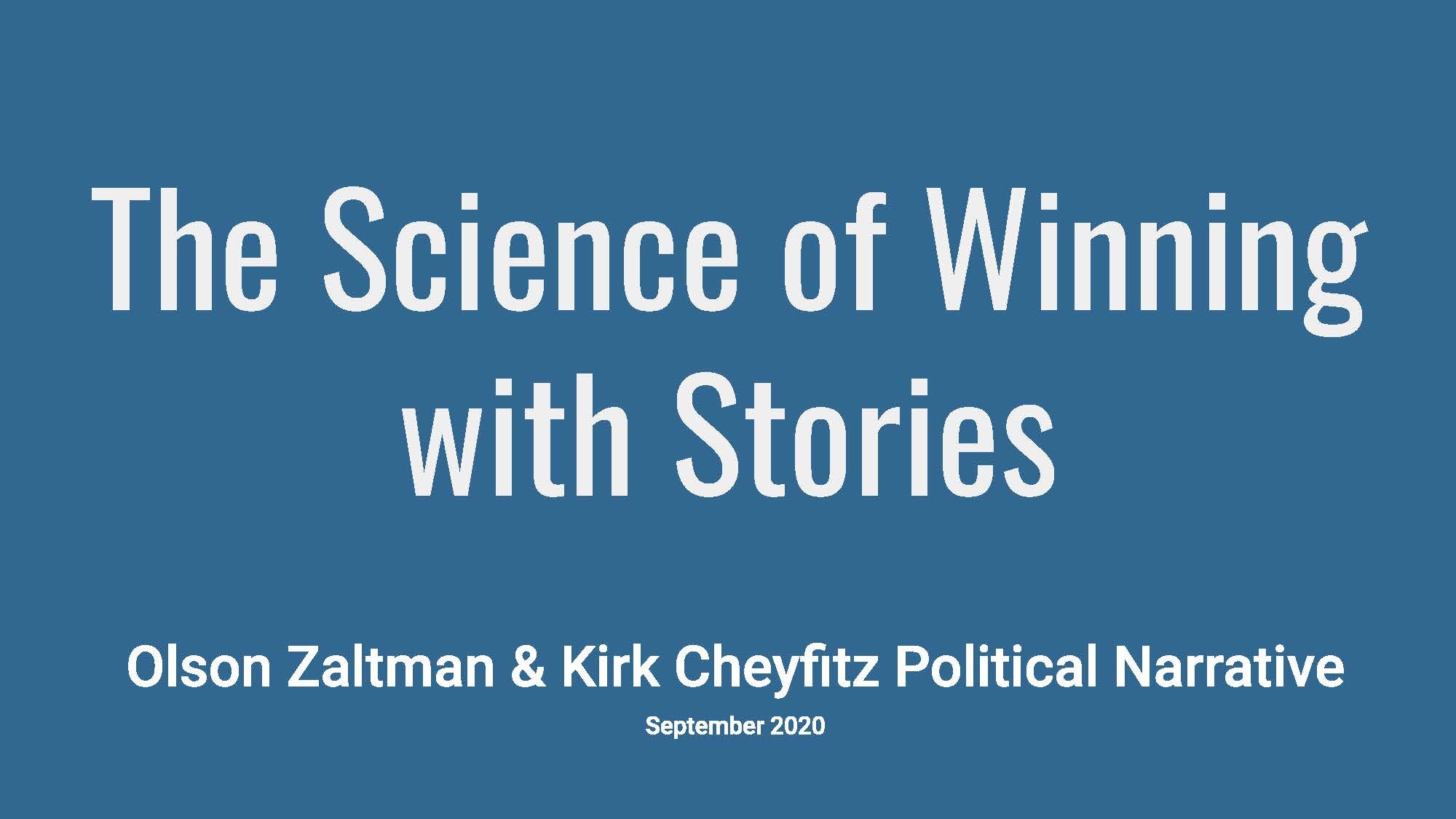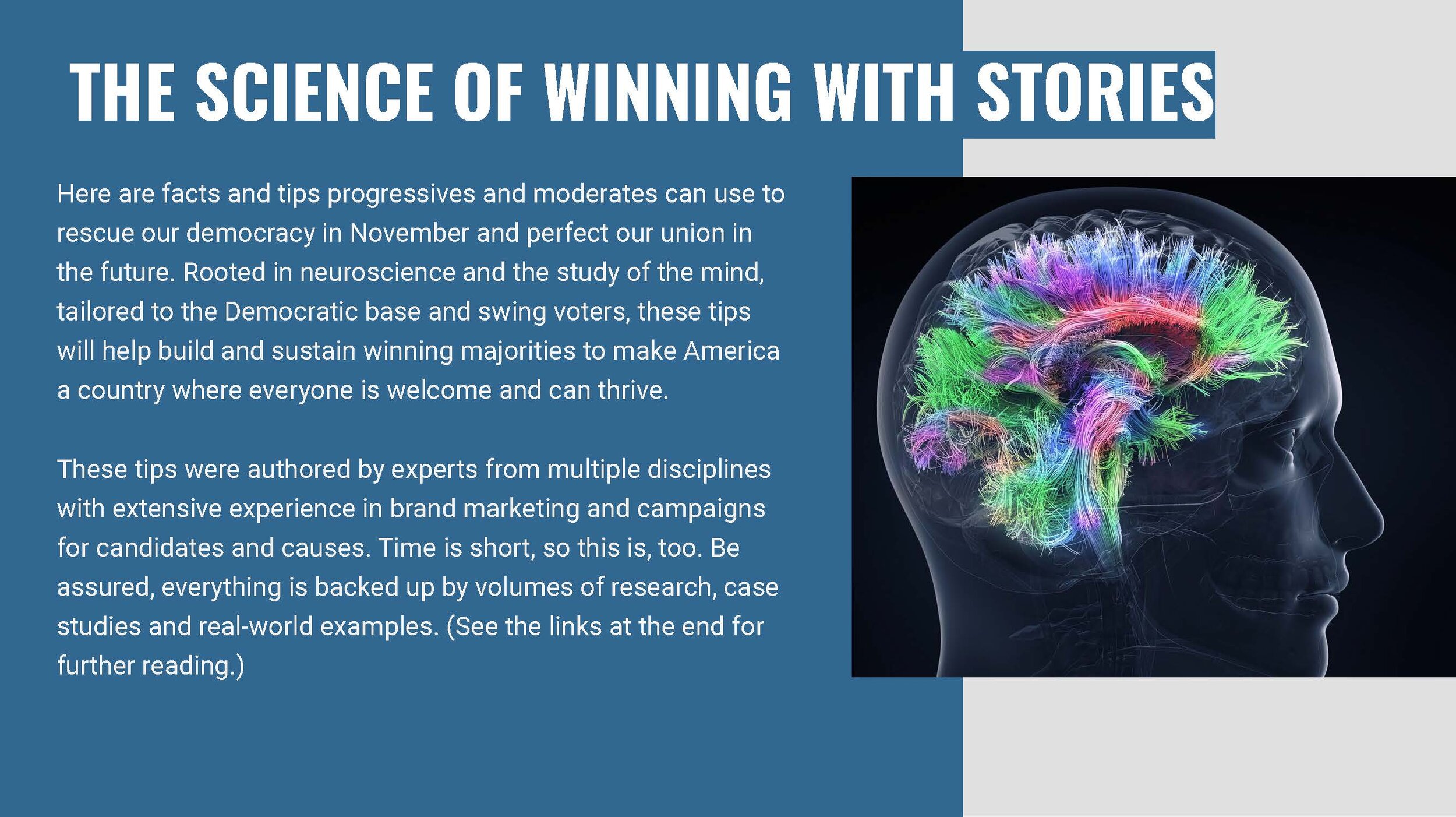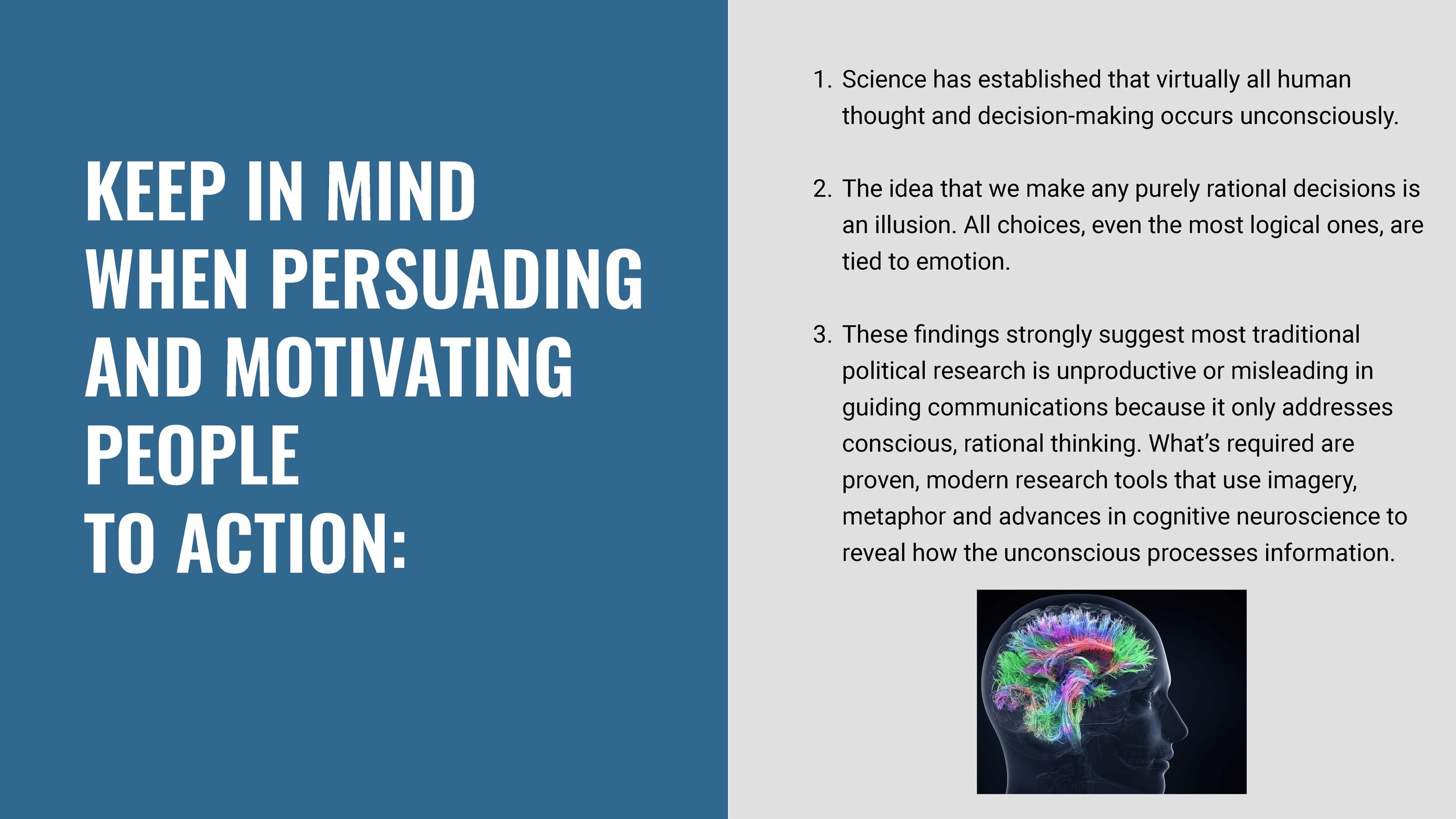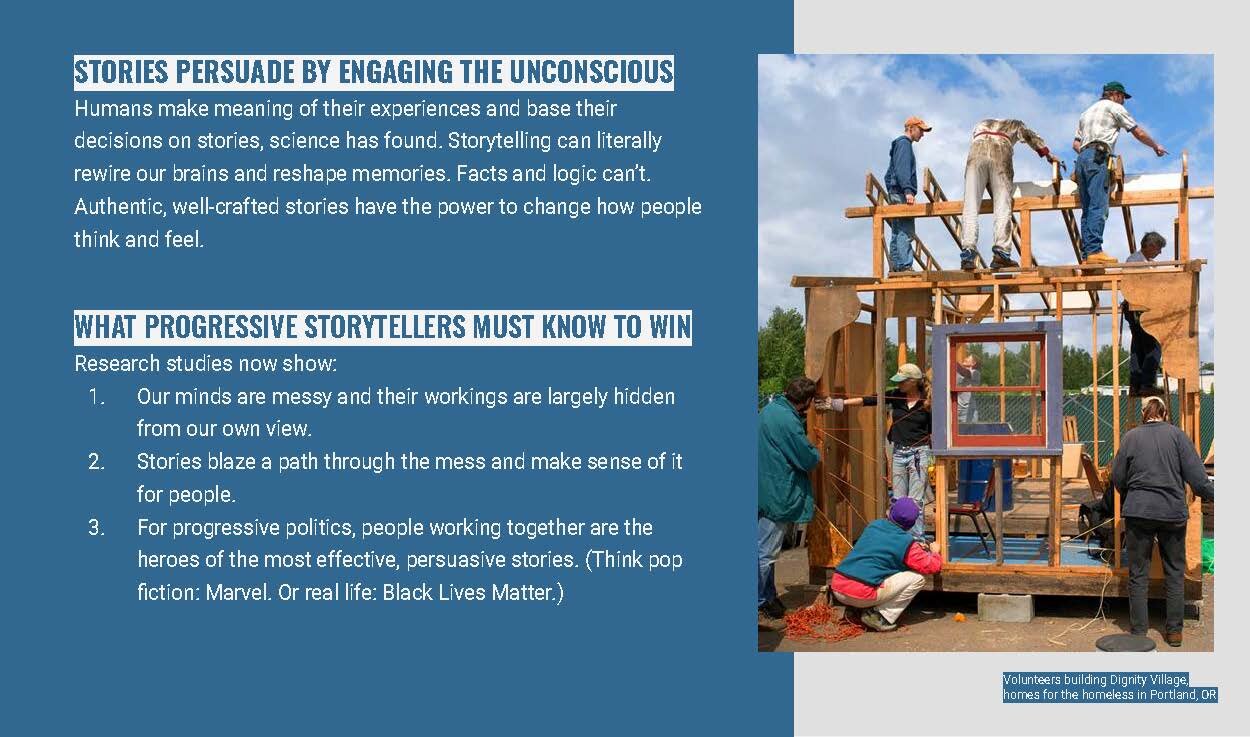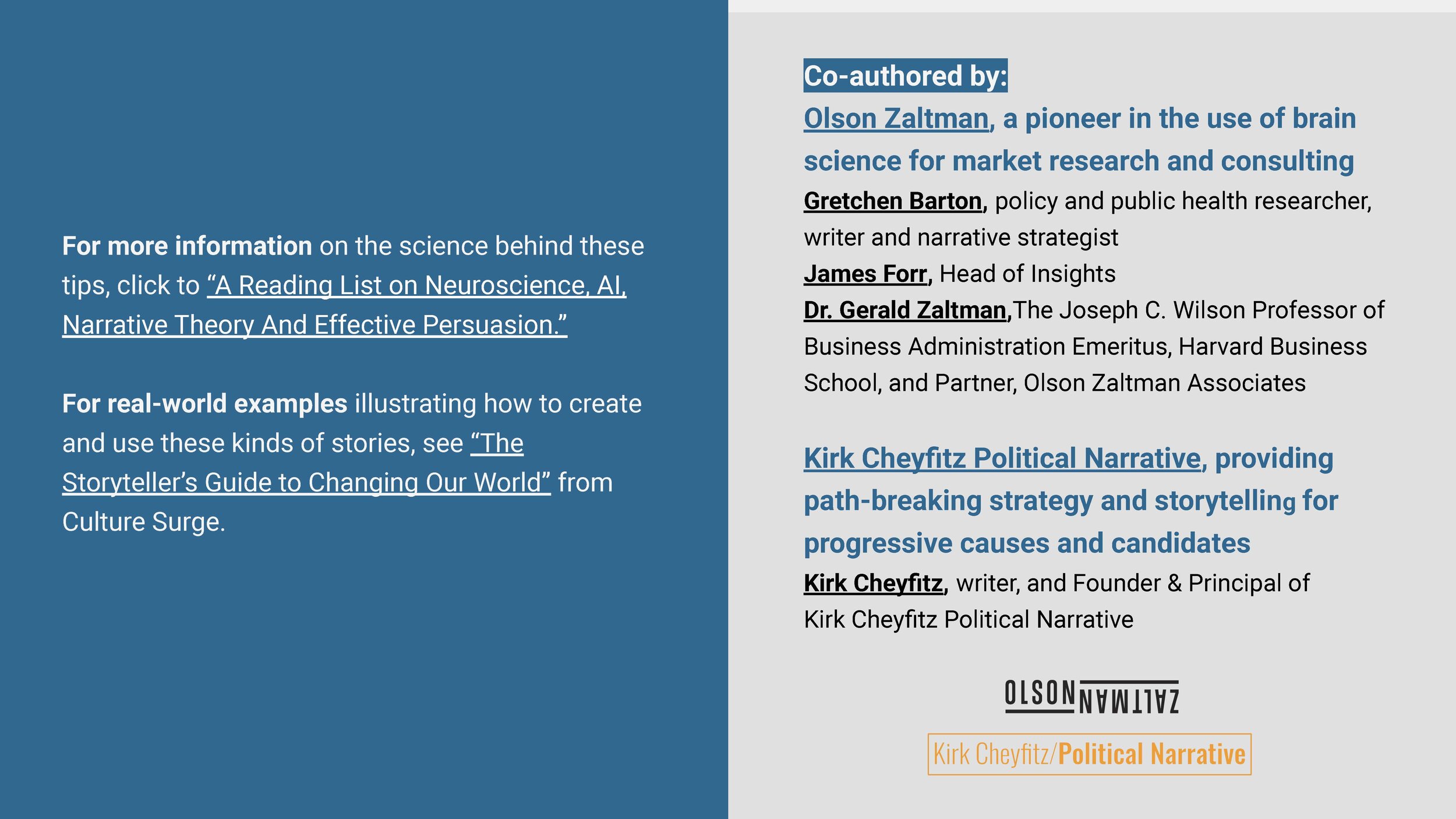A sampling of narrative ideas at work.
to discuss any project or see the studies behind them, Send an email.
The Science of Winning with Stories
A new guide, rooted in the science of the mind, helps progressive causes and campaigns create the most effective, persuasive communications possible.
"The Science of Winning with Stories” is a brief set of tips to help progressive causes and candidates create the most effective, persuasive communications possible. It leverages advances and scientific findings in an array of disciplines: neuroscience, psychology, narrative theory, artificial intelligence and more.
The guide is a collaboration with my friends and colleagues at Olson Zaltman Associates, an insight and research consultancy that has pioneered the use of brain science to fully understand how an audience thinks and feels and how to use these insights to influence how people think about products, issues, candidates, ideas.
Center for Cultural Power: No Going Back
The Center for Cultural Power, a national organization headquartered in Oakland, CA, needed to produce a narrative and cultural strategy guide for artists and activists to focus cultural production on using the COVID-19 pandemic as an opportunity for change. I consulted with them in on stories, recommending that the guide emphasize celebrating the power of people to make change for themselves — what I call “stories of agency.” Research from many directions had shown that such stories of triumph are far more successful producing action and sustaining movements than negative stories that merely describe the institutional obstacles and deep problems we face. The heart of what I recommended was a core narrative animated by optimism about the power of everyday people to unite and co-create the future they want and need.
The narrative guide was well suited to the historic moment created by the pandemic and its usefulness expanded as attention shifted unexpectedly and suddenly to the urgency of worldwide protests following the murder of George Floyd. As the opening letter of the guide says,
“Artists are the beacons who help us see the light in times of devastation. Artists expose hard truths, inspire new ideas and make the future we want feel possible, tangible, and inevitable. Artists activate the imagination, they soothe, comfort, and move to action.”
To see more about the project, go to the Center’s site.
UNILEVER'S COUNTRY CROCK: So much good happens when we bake
In early 2014, Unilever asked Story Worldwide, the storytelling agency I founded and led, to “change American culture” so that mothers would bake more and use Country Crock margarine instead of butter.
At that time, butter, advertised as a “natural” food, had been increasingly outselling margarine for three years. Traditional advertising had failed to turn that around; margarine’s market share was shrinking.
Assaulting people with repetitive products claims — ads about taste and ingredients, for example — does not work, especially since every competitor is making the same claims. (The same is true in politics, where promises of “freedom” and “opportunity” are made by both parties and policy memos have no persuasive power.)
Finding an authentic story, however, works incredibly well if the narrative creates an emotional connection between a brand and what's most important to the audience. This web film (above) launched a docu-series that changed the game for Country Crock margarine by connecting with what mothers see as their most important mission—raising children to be good people with solid values.
The case study (below) tells the how, the why and the impact of this multi-dimensional, multi-channel story that spread across TV, web, social and events. As I said to the clients, "There's no such thing as a 'low-interest' category; just low-interest advertising."
Country Crock's core brand story — their “Story Platform” — is "the magic of home." That's not a tagline or a consumer-facing message. It's a narrative platform to guide every story the brand tells. With that platform, it made sense to narrate how baking can help mothers pass along their values to their children. This story was then extended in an event (below) that combined kids' drawings, baking cookies and high-tech 3D printers to let kids create handmade cookies from their own imaginations.
Country Crock Credits: All the work above for Unilever was part of a multi-year collaborative effort between Story Worldwide and the folks at Unilever's Baking, Cooking & Spreads Company, then headed by Ben Crook. I headed Story's efforts.
SEI: Visual storytelling to make complex tech instantly accessible
SEI: making complex tech instantly understandable to c-suiters
The global wealth management industry has seen a revolution driven by globalization, changing regulations and more. SEI, long-time leader in outsourced technology and services to wealth management firms, anticipated this revolution by creating an entirely new approach to solving wealth management's growing problems. Their work succeeded with a flexible, future-proof software system — the SEI Wealth Platform. But the platform's advantages were so revolutionary, they proved hard to explain.
Solving this hinged on two insights: First, we had to describe the familiar problem before we could generate interest in the unfamiliar solution. The problem, honestly and bluntly presented, would get heads nodding. Second, we needed a powerful visual metaphor to introduce the concept without overwhelming people.
Finally, we needed to target the story to reach a tiny group of people spread across the globe: decision-makers for privates banks and sizable investment firms.
The film "Gears" (above) accomplished its mission in 75 seconds. Deployed as a web film, on screens in selected elevator cars and at in-person demos, it made the SEI Wealth Platform's potential instantly intriguing to a targeted set of senior C-suite managers.
Beech-Nut: Redefining "baby food" for Millennial moms
Beech-Nut: what do you SAY WHEN you launch something really new?
It's a truism of the modern marketplace that everything is a commodity and all product claims are, therefore, undifferentiating. Beech-Nut defied that rule. Their research revealed the 21st-century resurgence of moms' making homemade food for their babies. So Beech-Nut decided they, too, would embrace homemade with a line of premium, all-natural food in crystal clear jars that contain "just the stuff and nothing else," as Beech-Nut told us. But how do you talk about real differences when the words that describe good food — words like "natural" and "fresh" and "unadulterated" — have been devalued by misuse and overuse?
The answer, of course, is that you develop a unique visual language (see one of the print ads, above) that tells everyone the Beech-Nut jars contain "the stuff and nothing else." (And me be clear, of you turn that jar around and read the FDA-required label, it lists the sole ingredient as "100% carrots.") You amplify the iconic visuals with clear, direct words to that side with Millennial moms in rejecting the entire category of commercial baby food, creating a the new category of "real food for babies." The same story is on display in a different format in the TV spot (below).
Simultaneously, of course, it was important to create a raft of assets — images, short stories, videos — to give the audience all the online information to understand that Beech-Nut's claims are not merely claims, they're the real thing.
The net result of this multi-channel effort was that commercial baby food, which had been a shrinking category, began to grow again as these stories reached moms. And all the growth went to Beech-Nut's new line of real food for babies.


